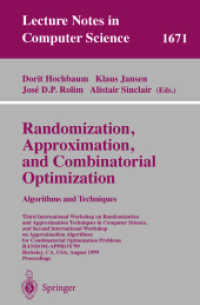- ホーム
- > 洋書
- > 英文書
- > Science / Mathematics
Full Description
Computational Materials Sciencecomputational science and explains how computational tools and techniques work to help solve materials science problems. The book focuses on two levels of a materials system: the electronic structure level of nuclei and electrons and the atomistic/molecular level. It presents computational treatments of these system levels using molecular dynamics (MD) and first-principles methods, since they are most relevant in materials science and engineering. After a general overview of computational science, the text introduces MD methods based on classical mechanics and covers their implementation with run examples of XMD and LAMMPS. The author discusses first-principles methods based on quantum mechanics at an introductory level, using illustrations and analogies to assist students in understanding this difficult subject. The book then describes the density functional theory (DFT)-the first-principles method that can handle materials practically. It also reveals how each orbital of electron leads to particular properties of solids, such as total energy, band structure, and barrier energy. The final chapter implements the DFT into actual calculations with various run examples via the VASP program.Computational methods are contributing more than ever to the development of advanced materials and new applications. For students and newcomers to computational science, this text shows how computational science can be used as a tool for solving materials problems. Further reading sections provide students with more advanced references.
Contents
IntroductionComputational materials scienceMethods in computational materials scienceComputersMolecular DynamicsIntroductionPotentialsSolutions for Newton's equations of motionInitializationIntegration/equilibrationData productionMD Exercises with XMD and LAMMPSPotential curve of AlMelting of Ni clusterSintering of Ni nanoparticlesSpeed distribution of Ar gas: A computer experimentSiC deposition on Si(001)Yield mechanism of Au nanowireNanodroplet of water wrapped by graphene nanoribbonFirst-Principles MethodsQuantum mechanics: The beginningSchroedinger's wave equationEarly first-principles calculationsDensity Functional TheoryIntroductionKohn-Sham approachKohn-Sham equationsExchange-correlation functionalSolving Kohn-Sham equationsDFT extensions and limitationsTreating SolidsPseudopotential approachReducing the calculation sizeBloch theoremPlane-wave expansionsSome practical topicsPractical algorithms for DFT runsDFT Exercises with VASPVASPPt-atomPt-FCCConvergence testsPt-bulkPt(111)-surfaceNudged elastic band methodPt(111)-catalystBand structure of siliconPhonon calculation for siliconAppendix 1: List of symbols and abbreviationsAppendix 2: Linux basic commandsAppendix 3: Convenient scriptsAppendix 4: The Greek alphabetAppendix 5: SI prefixesAppendix 6: Atomic unitsIndexReferences appear at the end of each chapter.

![オーディトリー・バーバル・セラピー[AVT]の理解と実践 - 難聴児のことばを豊かに育むための聴覚活用](../images/goods/ar2/web/imgdata2/47614/4761408537.jpg)






